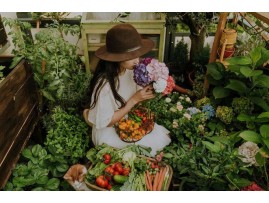
8 Square Meter Balcony Garden——Planting
02/12/2021
The story of a girl and her eight-square-meter Garden——Planting. This is her story:
“The apartment I rented has only a small balcony of 8 square meters. When summer comes, the balcony is usually empty and the heat is unbearable. At the beginning of 2020, I embarked on a journey of turning my balcony into a green paradise. This must be changed. A few months later, I realized that cultivating a garden is not only to feed myself but also to feed my soul. From late February to early March, when the last snow begins to melt, it's a good time to start preparing for summer gardening.
1) Planning the layout and cleaning the balcony
-Measure and draw vegetable floor plans to optimize and maximize the balcony area.
-Draw the design of the movable bed to make the process of buying wood easier.
-Because the weather in Germany is very cold and it won't be warm until the end of May, so buy a small greenhouse to sow in advance.
-Clean the balcony: the floor, remove the dirt from last year, pull the weeds.
2) Making movable flower beds
Elevating the flower bed is nothing new. Putting the flower bed up will not only make the place look neater, but also make the plants grow better, easier to handle and mix the soil, and avoid snails. . . Especially when planting, harvesting, and pulling weeds, you no longer need to bend over, just like planting on a low flower bed.
In Germany, the size of a heightened flower bed can reach 200 x 300 cm! ! Because we only have a small balcony, I built some small flower beds temporarily, the size is D45 x L100 x H40 cm.
Three types of wood are applicable:
-Fir (Douglasie): EUR 3/meter
-Pinewood: 3 euros/meter (I use this)
-Larch: EUR 4/meter
I made a lot of holes in the bottom to ventilate the soil and avoid standing water. Use paint/oil to protect and extend the life of the wood, remember to choose an environmentally friendly one. This is not only good for the environment but also good for our own health. Another way to increase the life of the wood is to add a cover to the flower bed.
There are two types of packaging that are most suitable for flower beds: EPDM and bubble packaging. Note: Do not use PVC packaging! Toxins will enter the soil and fruits and vegetables.
3) Soil preparation and fertilization
Fertilizer
-I use Bokashi compost to make fertilizer from organic kitchen waste. Our kitchen is now odorless and zero waste, organic waste is now decomposed faster than traditional compost
-In Bokashi compost, all kinds of kitchen wastes-including meat and dairy products that are prohibited from the aerobic system-are mixed with some inoculated bran, pressed into a Bokashi barrel, covered with another bran, and then tightly covered. Put it aside. After twelve days, the bucket will be closed. Every other day, leachate, an inevitable by-product of anaerobic composting, needs to be discharged. This is the only thing that needs attention.
When the trash can is full, cover it tightly and place it in a place away from direct sunlight for about 10 days in the house. Every other day, pump out the liquid, which can obviously be used as fertilizer (in a very diluted form) or to control the slime in sewers, pipes, and septic tank systems. After ten to fourteen days, the garbage in the bokashi barrel should be thoroughly pickled, and then it can be dug into the flower bed on the balcony.
Soil
-There is a layer of clay particles at the bottom to enhance drainage.
-Then mix the soil and fertilizer from the Bokashi bin (2 weeks after the bin is filled), mix the Bokashi fertilizer! Then cover with a thick layer of soil to completely cover the mixture of soil and bokashi. Before sowing, cover or wrap it up and incubate for at least 2 weeks, and I incubate it for another month.
Buy soil for growing vegetables, don't buy soil for growing flowers to save money. The flowering soil will inhibit plant growth and make vegetables bloom earlier. For example, early-flowering cabbage can no longer be harvested. These flowers can only be used to collect seeds. With this mixture, the vegetables will have enough fertilizer to supply the whole season. Some vegetables, such as tomatoes, require only a little extra potassium during the flowering season.
4) Budding
-Because of the cold weather in Germany, if you want to harvest in early July, you have to germinate early. The end of March and the beginning of April are the right time to do so. Because this is my first year, I chose plants that are easy to grow and cultivate, such as tomatoes, lettuce, herbs, vegetables, kidney beans, zucchini, and cucumbers. . .
-For plants that need to germinate indoors: + Use special soil for sowing, which can increase the germination rate of seeds and provide a good starting point for plants. Then use egg cartons and milk cartons for sowing. If you sow in large quantities, you can also buy special small pots.
Write down the name and date of sowing to facilitate monitoring. The seeds usually germinate after 14-7 days. By the window, there is plenty of light. If you are in Germany: If the seeds fall on the windowsill, do not turn on the heater.
The germination rate is not 100%, so it is best to sow more seeds to ensure that you will have enough plants. This also gives you the option of growing healthier and stronger plants, Because they will grow better and are more suitable for future planting.
After the plants have sprouted for a period of time, they can be moved to larger pots. When the night temperature is higher than 10°C (usually mid to late May), they can be grown outdoors. Before that, put it in a greenhouse (optional) for a few days to allow the plants to adapt to the weather and to the outdoor temperature.
-For plant types that can germinate outdoors:
Vegetables such as greens and radishes. . . From the end of February, it can be planted directly outdoors. If you have a greenhouse, some vegetables can be planted at the end of February and mid-March: carrots, cabbage, some vanilla. . . When the night temperature is above 10℃, sowing can be done outdoors.
Some kinds of vegetables also require a germination temperature of more than 15°C, so remember to pay attention to each plant.”
This is the planting story of her and her eight-square-meter balcony garden. Let us look forward to her next story——a good harvest.
